Loic Leferme’s entry into the pantheon of the greatest freedivers of all time is long overdue.
The no-limits master from Villefranche-sur-Mer has now bested the deepest mark claimed by anyone in an official record event with his dive of 171 metres on October 30, 2004. He is deeper than all the big names in no-limits freediving: Pipin Ferreras, Umberto Pelizzari, Audrey Mestre, and Tanya Streeter.
I first met Loic Leferme in Ibiza, Spain where he coached the French freediving team at the 2001 AIDA World Championships. In person, he is the antithesis of the burly Cuban and the tall Italian in physical presence and the trappings of celebrity. Leferme’s compact and slim physique is neither imposing nor overly athletic. Rather, he has the body of a man made to fit tightly on a sled, for the powerful rush of descent.
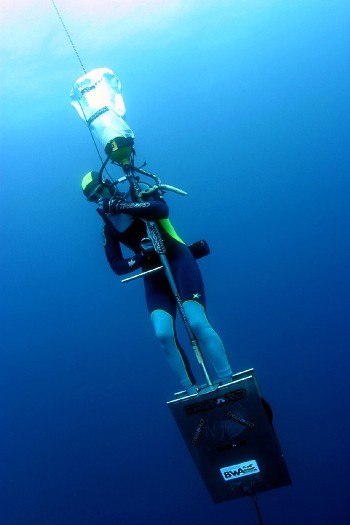
And, despite a new world record of 154 metres that same year, Leferme was already pushed out of the spotlight by Pelizzari, who was the anchor of the winning Italian team, Herbert Nitsch’s constant weight world record, and also by the hype surrounding the arrival of a quiet Czech freediver named Martin Stepanek.
An elite freediver’s motivation is a curious thing. Why do freedivers want to be the deepest in the world? Why do they risk the very real dangers of narcosis, decompression sickness, equipment failure and accidents that occur more than one hundred metres below the surface?
Adventure, more than anything, is what motivates Loic Leferme to plunge beneath the surface. On the phone from his home in Nice, France, he likes the idea that he is participating in a great exploration of the human being in the underwater realm. The decade he has spent in pursuit of records and sponsorship are not in the service of the great egotism of wanting to be the best in the world. In the end, it turns out that in Ibiza, relegated to the sidelines by Nitsch, Pelizzari and Stepanek, Leferme was staying true to his character. Profil bas, after all.
“There are one hundred freedivers who are better than I am,” Leferme says, “But few have the advantages that I have for training and the motivation.”
If Pipin was a talented self-promoter and media-magnet, then Loic Leferme is the underwater explorer who has put in the time to know his arena inside out. His pursuit of “profondeur absolute” or absolute depth, as he prefers to call no-limits, hinting at his adventurous spirit, is something that extends beyond media attention and world records. It is an adventure that fills his life and attracts other freedivers to support him.
For fifteen years, Leferme has been training with the same core group of people from Villefranche-sur-Mer. His world records are the result of the efforts of the whole team of ten or so friends who have joined his adventure. His wife Valerie is the coordinator for Leferme’s communications with the public, the media and his sponsors. Close friends, Francois Gautier and Cedric Palerme, head logistics and safety. And on October 30, 2004, an additional forty people volunteered to help with the attempt.
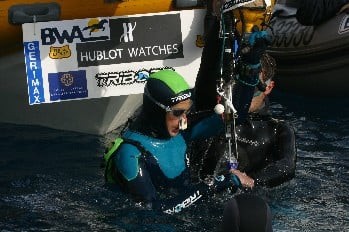
But that is not so unusual. Crowded media and volunteer boats are ubiquitous at high profile freediving events. Pelizzari also trained and set world records with a closely-knit team. What really sets Leferme apart is the philosophical glue that holds his group of freedivers together. A philosophy inspired by Claude Chapuis, one of the founders of AIDA, and retained for over fifteen years.
“It is our way of doings things that is unique,” says Leferme. “It is our spirit of group security that has developed a system of etiquette and philosophy that holds good sensations as primary over the performance of the individual.
“We embody this approach through the overall structure of our preparations and training. I never decide on depth or targets; it is the group’s decision and the group’s success when we achieve our goal.”
In training, Leferme was able to equalize at over 170 metres, meaning that going well over 180 metres was achievable. But the goal of his team was to achieve a world record, so they settled on the sure thing for the sake of the team.
The loyalty of his team – fifteen years is a long time – has allowed Loic Leferme to develop his no-limits diving above and beyond the skills of others, even Pipin and Pelizzari. Leferme is more like a mountain sherpa who lives on the slopes of the Himalayas and makes several trips to the summit a year, rather than the foreign climbers who arrive once every five years for rushed attempts to conquer the peaks with great media fanfare. In his quest to find the absolute depths of the ocean and within himself, Loic Leferme has a deep advantage over any other no-limits challenger: he has been training all year round, in the ocean, at significant depths, for many years.
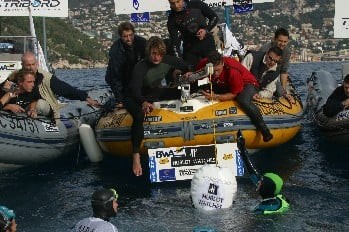
His continuous training has allowed him to adapt to deep dives perhaps more than anyone. Leferme doesn’t need to flood his sinuses with saline or seawater and uses a relatively slow descent to reach the bottom. And while narcosis is less of a factor in the warm waters of the Med, one might expected that the extreme pressure of Leferme’s dives would have a noticeable impact on his mental state.
“I used to get narcosis on shallower dives, especially on the ascent, and I soon realized that being cold and tired were the biggest factors. I made sure from that point onward to sleep well and stay warm. The water is 13 degrees Celsius down there but now even at 170 metres or deeper, I don’t feel any narcosis.”
Loic Leferme believes that being able to progress very slowly from one depth to another has allowed him to avoid the dangers of narcosis and decompression sickness. He likens it to mountain climbers on Everest getting acclimatized to altitude at base camp for months before attempting the summit. Earlier in his training he would breathe oxygen at 4 metres after a deep dive to reduce the risk of DCS. Now he no longer uses oxygen decompression and also rides the lift bag straight up to the surface. Most other no-limits freedivers release the lift bag at around 20 metres to allow for a slower ascent and for the body to off-gas the excess nitrogen; Leferme used to do this as well. However, now that his new safety system keeps him permanently attached to the lift bag, he has no choice but to surface rapidly. His adaptations made this safety system possible. It might not work for others who are less adapted. Leferme says he has never suffered from decompression sickness, unlike Pipin Ferreras.
“I take the time my body needs to adapt and I never surprise it with sudden changes in stress,” Leferme says. He is famous for his one metre increments during training, which at over 150 metres, seems not worth the effort of setting up each time. What about 200 metres? When will no-limits become too dangerous? “It’s not the absolute depths that are dangerous,” he says with emphasis, “it is the method of training and diving that can be dangerous. Humans can overcome any challenge if the right method is applied. This has been shown throughout our history.”
These years of practice – essentially in record conditions all year round – have also influenced the management of risk by Leferme’s team. The team has now dispensed with scuba divers all together. The diver and sled descend down a guide rope. There is a brake on the sled, but Leferme only uses it to release himself downward at the surface. From start to finish, the dive is timed meticulously. Because the system has been repeated so many times in training, the team knows exactly when Leferme should be on his way back to the surface. They give him a slight head start and then deploy a counter weight that raises the line and the sled under Leferme as he rockets to the surface with the lift bag. Should the lift bag fail to inflate or should he black out at the bottom, the bottom of the line is right beneath him and will bring him to the surface. The main difference between this system and counter weight systems for constant weight, is that the uncertainty of when to activate the counter weight is eliminated because it is activated every time, soon after the diver starts his ascent. The team also makes use of a Lowrance sonar to follow Leferme’s progress down and back up to the surface.
Leferme warns against other divers adopting his safety system out of context. “We have developed the system that supports the equipment we use to a high level. It is not just about using the counter weight every time. It is the team and the philosophy that we apply on every single dive.”
The parallels between no-limits and mountain climbing become more and more striking. Anyone who climbs a mountain summit, whether it is Everest or the Eiger, must make detailed preparations for the challenge. A climber of that ambition needs discipline, leadership, an excellent support team and the strength of mind, body and spirit to last all the way to the end. A hastily put together team and rushed training inevitably leads to disaster.
And when those crucial preparations are successful, the thirst for adventure can sometimes be quenched.
“The first world record was special,” Leferme remembers. “After all, it was the king of the freediving disciplines. I will never forget it. But the 171 metres dive was my most beautiful record. There was an ambience among us all, some were even crying when it was over. In part, I think it was because we had come this far over the years and had still managed to keep the original philosophy intact.”
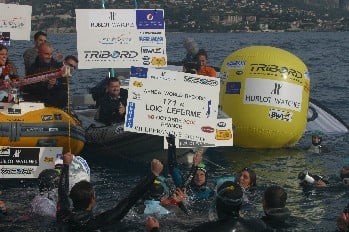
These adventures have led Loic Leferme to five world records in no-limits, a freediving expedition in the highlands of Afghanistan, many competitions, training courses for freedivers from around the world, and membership in an international community of underwater explorers.
Loic Leferme’s new record also came just after Belgian freediver Patrick Musimu announced an attempt to break the 200 metre “barrier.” While Musimu is an exceptional apneist and athlete, one can only wonder if he will be willing to invest the time and discipline to achieve his record with the same confidence and enjoyment that Leferme has demonstrated.
In the end, a certain kind of person will be drawn to the no-limits experience and to the adventure it entails. More will follow in the footsteps of Enzo Maiorca, Jacques Mayol, Pipin Ferreras, Deborah Andollo, Yasmin Dalkilic, Audrey Mestre, Mandy-Rae Cruickshank, Benjamin Franz, Umberto Pelizzari, Loic Leferme and others around the world, for there remains a special gravitas associated with the discipline. Is it the reliance on a kind of spaceship-type vessel to reach the abyss and return safely, complete with a mission control at the surface? Perhaps the horror of no-limits accidents raises the stakes for thrill seekers looking for an underwater Everest of their own. For certain, sled diving deeper than you can swim to the surface under your own power must invokes a feeling within freedivers that they are perhaps reluctant to share or just unable to express.
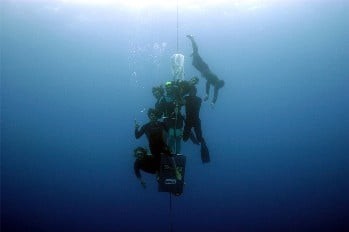
Loic Leferme sticks to the literal when asked what it feels like to ride the sled to the bottom: “I concentrate on the equalizations, my eyes are closed, my mask is full of water, and I find myself on the way down by the changes in pressure. I am squeezed, crushed, but I enjoy it; it no longer hurts me now. I hear the noise of the sled sliding down the line. It gets colder and then all dark.”
“But what about your thoughts and emotions?”
The phone is quiet for the length of time it takes Leferme’s heart to beat at 171 metres.
“How can one explain these personal sensations?”
Loic Leferme is sponsored by Tribord, Decathlon, Hubolt watches, and BWA, as well as many local businesses in Nice and the surrounding area. Suunto provided official gauges with Stingers and the new D9.
